I thought it would be easier to get the seals to sing to me. My great granny Mhairi used to sing to them in Stromness – and they’d call back with plaintive moans that sounded so much like the gales that have long darkened winters on islands like this one. This evening, though, the seals are silent and it’s the waves that are calling as the sun sets over the Atlantic and the Brough of Birsay.
From that sloping tidal island, Thorfinn the Mighty – most feared of Norse raiders – ruled and slashed his way across the north with a brutality that earned him the name Raven-Feeder (after the birds that fed on the corpses of his enemies). The St Magnus Way is not inspired by such bloodlust. Rather, it’s dedicated to the Raven-Feeder’s decidedly less violent grandson, Earl Magnus Erlendsson, who accepted being murdered so the people of Orkney could have peace.
This 58-mile pilgrimage route runs north to south across the Orkney mainland’s green heart, roughly following the path the body of Magnus was taken on after his death. He had shared the earldom of Orkney with his cousin Haakon, a fierce man seized with one desire – to rule alone. When the pair sailed to Egilsay in 1117 to put an end to their fighting and negotiate peace, Magnus was double-crossed – they’d agreed to bring just two boats, yet Haakon sailed in with eight, all filled with warriors. Magnus saw his fate and sailed on unarmed. He bent his head beneath the axe of Haakon’s tearful butcher while praying for the soul of his executioner – seeing this as the only way to prevent all-out war from devastating the lives of Orkney’s people.
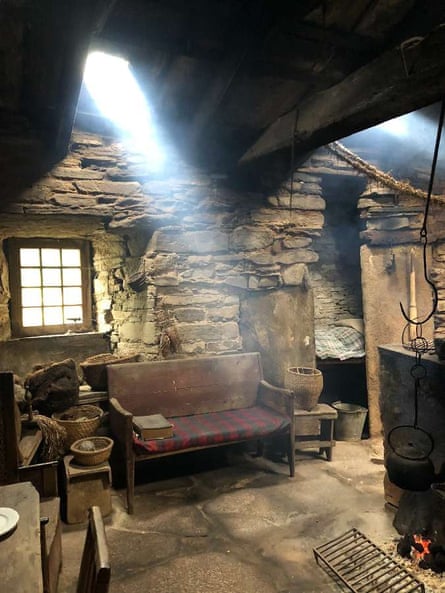
Magnus’s body was buried in Birsay for about 20 years. Pilgrims came to pray and reported miracles. Then his remains were carried to the town of Kirkjuvágr (that’d be Kirkwall), where his relics remain in St Magnus Cathedral to this day.
After day one’s 12.5-mile walk over dramatic sea cliffs from Evie to Birsay, hikers can stay at the Barony Hotel which has doubles from £90 B&B or Birsay Outdoor Centre has dorm beds and tent pitches from about £20. Birsay Bay Tearoom does soups and sandwiches with local produce. There’s also excellent lemon drizzle cake and more in the daffodil-hued JP Orkney Honest Box across the road from the ruins of Earl’s Palace.
In the morning, if your backpack’s not too heavy, make a detour to Birsay Books for a second-hand copy of The Orkneyinga Saga and particularly George Mackay Brown’s novel Magnus, which connects the violence and sanctity of the Norse world with today. George was my great-uncle, and I especially love how, in that book, he revealed the human within the saint.
Heading inland, across quiet back roads to Dounby, watch gannets turn to starlings and whale-humped hills guide the way. Perhaps you’ll see the odd cyclist as you go (there’s a St Magnus Way cycle route), but going slowly has its benefits. Between barbed-wire fences flecked with wool, you’ll spot countless hares and rabbits racing across the fields, and – if you’re lucky – short-eared owls.
Everyone has their own reasons for wanting to spend time in the beautiful, northern parts of the world. For some it’s to experience quiet. For others it’s to better understand the past. My great-uncle hoped to rescue the treasure of the centuries before it disappeared. “It is as though the past is a great ship that has gone ashore,” he wrote, “and a writer must gather as much of the rich squandered cargo as they can.” I seek out these places as a chance to watch fast-moving skies and lose my inhibitions. I think I want the chance to discover my inner “primeval, mischief-loving troll that dances along the edges of cliffs and writes pagan poetry”. That’s how George described a Stromness neighbour who wore an almost “ludicrously austere mask” in everyday life – yet was wild on the inside, beyond the town’s confines.
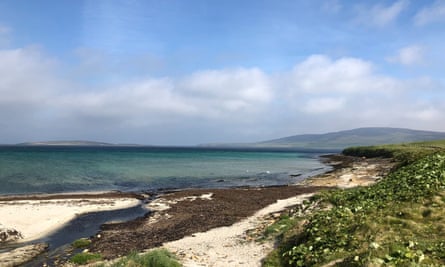
On this section of the journey, you may want to make a short detour to Kirbuster Farm Museum: it’s northern Europe’s last unrestored example of a traditional “firehoose”, with central peat hearth; it’s home to North Ronaldsay sheep (a breed known for its diet of seaweed) and the finest milking pails and heather brooms I’ve seen.
Warming yourself by that hearth, perhaps you’ll slip into romantic dreams of sleeping in that stone bed near the fire, and feel the magic of being surrounded by oil lamps and watching the stars piercing the night sky from the skylight above. With any luck, custodian Neil Leask will come in, point to that “skylight” – actually a hole for letting peat smoke escape – and say: “Oh yes, sometimes the people would wake in the morning to find a foot of snow had drifted in by their feet!”
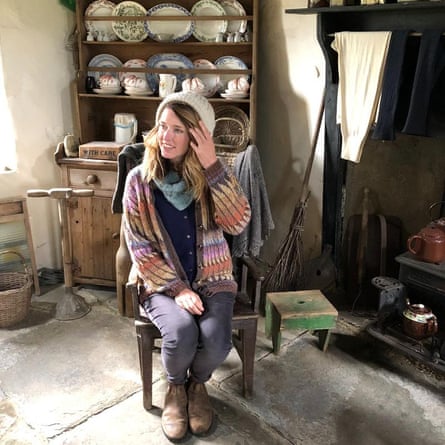
On you walk, into the village of Dounby where you’ll find the first, lit-up shop with regular hours since you began your walk. Stock up at the Co-op, then head to the Smithfield Hotel (doubles from about £110 B&B) across the street to eat and sleep.
As you head along quiet roads and track towards Finstown the next day, it’s hard not to be drawn in by the views of Hoy – its slopes catch the light like a luminous green iceberg. It’s hard not to want to run west to Maeshowe – a 5,000-year-old chambered cairn where Vikings took shelter from a snowstorm over 800 years ago. On bunkering in, they made carvings that collapse the distance between the people of the past and the present: “Ottarfila carved these runes.” “Ingigerth is the most beautiful.” Their graffiti differs little from what my pals and I used to Tippex on our school bags in Aberdeenshire. For some reason that feels moving.
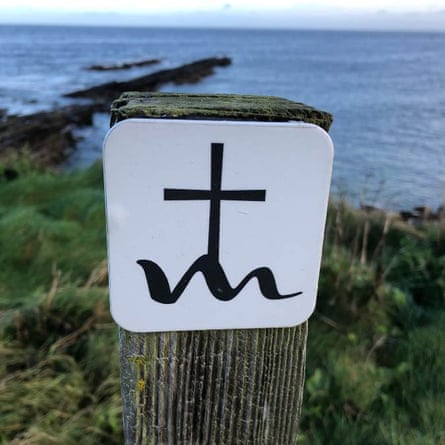
Around the village of Harray, you might start noticing signs for the Creative Orkney Trail (if you end up heading into Harray Potter, or the local woodturner’s studio in search of neolithic-inspired bowls, you won’t be the first). Then it’s onward into Binscarth Woods – entering a wind-cleaved tangle of beech and sycamore on a near-treeless island is always special – before a night in the long and lovely village of Finstown.
In the morning, walk between fields that have turned gold and green with the seasons for centuries to Orphir Round Kirk, Scotland’s only surviving circular medieval church. It was here that Earl Haakon got his trembling cook, Lifolf, to slay peace-seeking Magnus with a headblow from an axe, after which he ruled Orkney alone. He had everything he wanted, yet according to the Orkneyinga saga, his conscience was troubled. He made a pilgrimage to the Holy Land, repenting. Inspired by the Church of the Holy Sepulchre in Jerusalem, he had this little church built.
I like to imagine Haakon here in Orphir in his post-murder years: a complex man, deeply human (the people behind the Saint Magnus Way have themed this leg of the journey around forgiveness).
On the final leg of the St Magnus Way, Scapa Flow – a huge and storied natural harbour – opens like a big blue eye as you head towards Kirkwall and the towering St Magnus Cathedral. Britain’s most northerly cathedral, built in the 12th century, it saw pilgrims sailing in across ancient sea roads from Norway, Scotland and Ireland for years. But the Reformation put an end to the public worship of saints and miracles, and relics such as Magnus’s were hidden for safekeeping (Magnus’s bones – thought to be gone forever – were discovered by accident in 1919, inside a cathedral pillar).
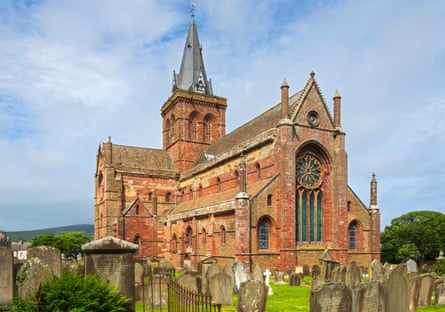
The church’s magnificent sandstone pillars stretch towards the vaulted ceiling, and I feel as if I’m walking inside a petrified golden grove. I’ve never seen anything like the medieval gravestones lining the walls, carved with crossbones and skulls – memento mori after memento mori. The last time I visited, I tried to sketch one: it depicted a woman next to an hourglass and a skull. As I sketched the crescent moon carved beside the skull’s right eye socket, a custodian sidled up and asked if I knew what it was doing there. I shook my head. He whispered: “They used to carve those so the souls of the dead could escape.”
The Norse people believed in souls too. They believed that dwelling in each of us was the spirit of one of our wise female ancestors. A fylgja was a guardian who guided our steps and watched over us. It’s a beautiful thought. It’s also beautiful to be thinking of a woman who sang to seals. Beautiful too, heading into the last gleams of evening light as Kirkwall’s young folk head out down the twisting wynds of an ancient town. “Each step brings peace closer. Every breath is a newfound song.” That’s the motto of the St Magnus Way.
The free St Magnus Way app contains GPX, maps and stories. For a longer journey, there’s an option to begin further north on the isle of Egilsay, reached by ferry from Tingwall near Evie.
Getting there NorthLink ferries run between Aberdeen and Kirkwall, and between Scrabster and Stromness. Pentland ferries run from Gills Bay (near John o’Groats) to St Margaret’s Hope on South Ronaldsay












